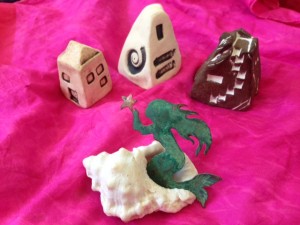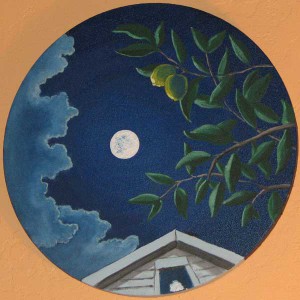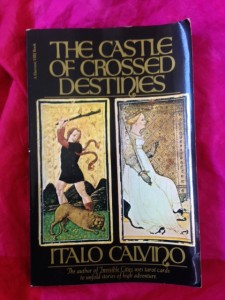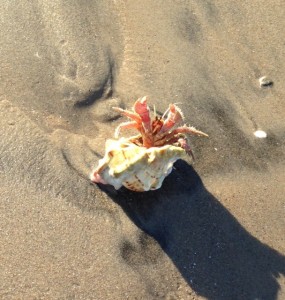 I’m in transition again, moving houses. Not solely due to the sale of our house in the woods prompting Tarot Haiku reflections, but due to an opportunity to move into a new house of my writing. Like the hermit crab we found at the ocean, roof to the shore, I’m coming out of hiding to step over a new threshold and more fully into the house of Tarot Writing. This year I’m extending my services as a poet, artist, and teacher to include Tarot related services you’ll find at the bottom of the post. First, I invite you to take a tour through the ways you can use the Tarot for your own writing practice right now.
I’m in transition again, moving houses. Not solely due to the sale of our house in the woods prompting Tarot Haiku reflections, but due to an opportunity to move into a new house of my writing. Like the hermit crab we found at the ocean, roof to the shore, I’m coming out of hiding to step over a new threshold and more fully into the house of Tarot Writing. This year I’m extending my services as a poet, artist, and teacher to include Tarot related services you’ll find at the bottom of the post. First, I invite you to take a tour through the ways you can use the Tarot for your own writing practice right now.
Tarot writing is the steady practice of using the Tarot cards to inspire your journal writing or your professional writing and projects. Below you’ll find some approaches to using the Tarot I’ve been experimenting with during the twenty plus years I’ve been a poet, artist, and Tarot lover.
Journaling to the Tarot
As a series of pictorial representations of the challenges and blessings common to the human condition, the Tarot provides beautiful inspiration for journaling. Try drawing one card randomly from the deck at a time and committing to a daily, weekly, or monthly practice of journaling to that card. Free-write to make connections between the images on the card and your present life experience. Or you may wish to use your card selection in a visionary manner, inviting the imagery on the card to inspire you to write your way towards a new direction for your life. You set the question when you pull the card—so you may point the arrow of your inquiry where you will.
If You are New to the Tarot, but Curious:
Here’s a gentle way to approach the Tarot, whether you are getting ready to go out and purchase your first deck or you have a deck sitting around the house you’ve meant to open. Or perhaps you want to deepen your understanding of the cards you currently use.
You’ll find a wealth of Tarot decks and great diversity regarding interpretations for each card, but typically, a deck consists of Major Arcana or “soul” cards meant to depict stages of the “hero’s journey” of incarnation over the span of a lifetime as well as Minor Arcana cards meant to depict the hero’s “mundane” or daily journey.
These Minor Arcana cards, Ace through Ten, are divided into four ways of experiencing our circumstances: through the element of earth (material comforts and hearth–represented often by pentacles), air (intellect and mind–swords), fire (passion and will–wands), and water (emotion and heart–cups).
 Here’s a Four Elements Notebook Exercise to try:
Here’s a Four Elements Notebook Exercise to try:
1 Acquire four notebooks: one for each element: Earth, Air, Fire, and Water. Image hunt for covers that reflect your associations with each element or if inclined, create your own artwork or collage for each notebook cover.
2 Begin to record your experiences of each of the elements daily, weekly, or monthly as best supports your writing practice. You might start with a seed question for each suit: Earth: Home and hearth mean the following to me… Air: I point the arrow of my thoughts in the following directions… Fire: I am passionately motivated in my life in the following ways…. Water: I offer/receive the cup of love in the following ways…
3 When ready, add to this practice the selection of a Tarot card from each suit to place out in view on your writing desk. Give yourself a set amount of time (day, week, or month) to live with the card. At the end of your chosen timeframe, explore your living experiences in relation to the cards you drew for each element. Pace the exercise appropriately for you—focus on one element at a time if you prefer.
A version of this exercise appeared originally as a guest post at Free the Pen.
Using Tarot Cards to Inspire Plot
 Alternately, if you already have some working knowledge of the cards, you can use them in the service of your fiction plot, poem arc, or memoir structure. The Italian novelist Italo Calvino used the cards to structure what I think of as his version of the Tarot Canterbury Tales. The difference is that in the “The Castle of Crossed Destinies” and “Tavern of Crossed Destinies,” (both housed in the book pictured here) Calvino’s travelers arrive at their destination in the woods only to find themselves mute. They resort to using the cards to share their life experiences in a series of tales including The Tale of the Alchemist Who Sold His Soul and the Tale of the Vampire’s Knowledge. Calvino includes a story about his own relationship to writing in “I Also Try to Tell My Tale.”
Alternately, if you already have some working knowledge of the cards, you can use them in the service of your fiction plot, poem arc, or memoir structure. The Italian novelist Italo Calvino used the cards to structure what I think of as his version of the Tarot Canterbury Tales. The difference is that in the “The Castle of Crossed Destinies” and “Tavern of Crossed Destinies,” (both housed in the book pictured here) Calvino’s travelers arrive at their destination in the woods only to find themselves mute. They resort to using the cards to share their life experiences in a series of tales including The Tale of the Alchemist Who Sold His Soul and the Tale of the Vampire’s Knowledge. Calvino includes a story about his own relationship to writing in “I Also Try to Tell My Tale.”
In closing notes, Calvino admits the Tarot structured book obsessed him; in fact he abandoned it at one point. He writes, “I publish this book to be free of it: it has obsessed me for years.” He states his intent was to create a “Shakespearean pastiche” with Hamlet, Macbeth, King Lear, Faust, Parsifal, and Oediupus storylines. Calvino combines images and text by running the cards in some cases vertically down the margins of his pages; you’ll also find an image of the entire deck laid out in such a manner that each of the rows, depending on where you “enter” follow Calvino’s tale threads. It is easy to see why he felt overwhelmed by the multiple story threads and possibilities.
Using Tarot Cards for Writer’s Block or Artistic Inspiration
Here’s a more manageable exercise inspired by of Calvino’s ambitious project. You may wish to select Tarot cards around a particular block or challenge you are having with a manuscript or project. In this case, the cards in your reading give you inspiration for the next steps towards your project, or in the case of writing, form the basis for the next part of your plot, focus for a chapter or stanza of your poem. This method easily applies to artists. If you are a painter, sculptor, or a photographer, you use each card as the basis for inspiration for your next painting or photographic inquiry.
Traveling the Royal Road of Tarot with a Friend
It also makes sense to travel the Royal Road of Tarot together. Having the reflective mirror of another mind when interpreting the cards, especially in relation to yourself, helps keep your outlook optimistic, helps keep you accountable to your writing schedule, and is undeniably a fabulous way to deepen a friendship.
For an example of this, visit Tarot for Two where writer Mary Allen and I have traveled together publicly on the Royal Road since 2015 (though our private Tarot journey began over twenty years ago). At Tarot for Two, we write to cards of the month as we live them and attempt to make sense of how our inner worlds meet our outer worlds. We use our card as a focal point to make sense of the month’s interactions, often calling on the card of the month to make sense of both challenges and blessings at hand. It is our hope to inspire other pairs of friends to start their Tarot Writing journey together.
Traveling the Royal Road of Tarot with other Students of the Tarot
Here are a few additional ways you can begin your own Tarot Journey in the company of like-minded Tarot-curious and inspired writers and artists:
Stop by Tarot Tuesday’s Facebook page at Wheel of Archetypal Selves Tarot for free writing prompts. Join me as we move sequentially through the deck one card at a time, week by week. I welcome your questions and your responses to the prompts in that forum. You’ll find prompts so far for the Ace of Cups, Two of Cups, and Three of Cups.
Sign up for one of my theme-based Tarot Writing courses. We are in session with Wheel of Archetypal Selves: The Many Faces of Love. Next six-week online course, Wheel of Archetypal Selves: Taming the Faces of Fear, starts April 4, 2016; course description and link forthcoming shortly.
Sign up for an individual Tarot Consult. My Tarot as Project Mirror consult offers writers and artists a look at a specific project of your choice and comes with individualized writing prompts based on the cards that fall for you. For more information about the consults I offer, visit this post on 2016 New Tarot Services. My gratitude goes to A Room of Her Own Foundation for the fellowship to attend last year’s summer retreat and for the opportunity to debut the Tarot as Poet’s Mirror consults with writing prompts.
Artwork Credits:
The houses in the photo at the top of this post are made of clay by my poetry movie collaborator Robyn Beattie.
Painting of the Moon through the Lemon Tree is by Peter Pryputniewicz.
Related Links:
Conjuring of a Poet Tarot Deck: An Interview with Two Sylvia’s Press
The Castle of Crossed Destinies by Italo Calvino at Ex Libris: Architecture and World Literature, analysis by Carly Dean
Aeclectic Tarot Forum: Tarot Spreads for Writers and Artists:
Tarot for Writers by Corrine Kenner
Link additions, March 4, 2016:
‘The Ghetto Tarot’: Haitian Artists Transform Classic Tarot Deck into Stunning Real Life Scenes
Making the Tarot Literary Again by Peter Bebergal up at The New Yorker (takes a look at a book by Jessa Crispin, The Creative Tarot: A Modern Guide to An Inspired Life)

